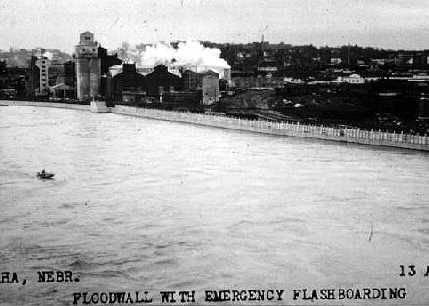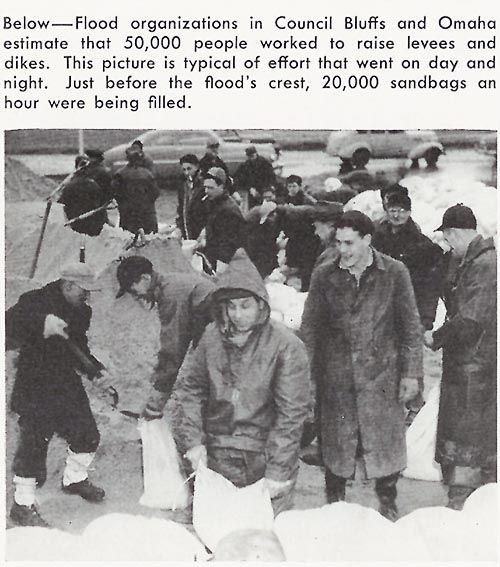The Wild Missouri
Pottawattamie County
Emma Husar
4/17/1952


 The “Big Muddy” strikes again. The culprit: none other than the rapidly melting snow in Montana and South Dakota. For Council Bluffs, it had been 62 years since the community was threatened by waters that gushed into the lower Missouri River; this time cresting at 22.45 feet in the midst of the Second World War in early April of 1943.
The “Big Muddy” strikes again. The culprit: none other than the rapidly melting snow in Montana and South Dakota. For Council Bluffs, it had been 62 years since the community was threatened by waters that gushed into the lower Missouri River; this time cresting at 22.45 feet in the midst of the Second World War in early April of 1943.
Flood waters splayed over the lowlands of Council Bluffs, inland 16 miles, drowning 700,000 acres of agricultural land and leaving many people homeless. Little did residents know that would be only the first of three total floods that year. Heavy rains in May caused 540,000 more acres to flood and yet more in June.
The cost was equally as heavy. An estimated 8 million dollars in damages made the Omaha-Council Bluffs area rethink the construction of levees and dams along and in the Missouri River. The Missouri River Basin Education Network accurately puts it:“the flood of 1943 was a turning point in flood management on the Missouri River.” One year later Congress passed the Flood Control Act of 1944 that authorized a levee system as well as 6 dams along the river.
 A documentary entitled Man Against the River explains:
A documentary entitled Man Against the River explains:
Never before had such a massive project been undertaken. Thousands of workers technicians and laborers, tons of steel and concrete, acres of earth and rock. The construction of the dams on the Missouri River required 1.1 billion dollars across six years; the six reservoirs constructed can hold enough water to cover the entire state of Nebraska to a depth of 18 inches.
However grand the project, its architects did not expect the river to flood again in such a short time span. Only nine years later in 1952, before all the levees and dams were yet completed, the Wild Missouri swelled to unprecedented degrees once more due to unforeseen and rapidly melting snow up north.
Man Against the River, produced by Dave Hamer in 1982 harkens back to the astounding flood in 1952 that tested the people’s newfound knowledge on flood containment. Featuring Edward R. Murrow, the opening footage gazes upon one big, white light piercing the dead night. It creeps across the banks of the river, momentarily illuminating workmen who pile sandbags in order to prevent the flood from consuming their home and lives.

 These men and women came from as far as Kansas, Massachusetts and California to work for shifts as long as 48 hours. Bank clerks, insurance salesmen, mechanics and more from Omaha-Council Bluffs received leave from work or simply left to volunteer their time to protect their cities.
These men and women came from as far as Kansas, Massachusetts and California to work for shifts as long as 48 hours. Bank clerks, insurance salesmen, mechanics and more from Omaha-Council Bluffs received leave from work or simply left to volunteer their time to protect their cities.
One insurance salesman from Omaha commented on his part:
I sit behind what they call a desk all day long, well when this emergency arose we feel these here are the people we have to serve throughout our life and so we were down here working—many of us down here working, like myself—we finished up last night on a 36 hour shift with about one and a half hours of sleep. We came out bright an’ early this morning until it’s over with.
Bill Billotte, a local news reporter, recounts, “An army it was, with its members using sandbags instead of bullets to fight as savage an enemy as has ever faced this country.” A sandbag wall of 15 feet was completed to protect against the creation of a new dike on the west side of the river. The “herculean efforts of both cities” was hoped to be successful; however, many were reported to being as “superstitious about discussing the chances as ball players watching a no-hit, no-run game in the making.”
At 4:30 in the morning on April 17, 1952, the flood was predicted to hit. The estimated 50,000 volunteers behind their sandbags watched as the waters rose to a depth of 30 ft., 11 ft. higher than usual, but below the height of their walls. Their anxiety receded with the river as it swelled downstream. After capturing the struggle and triumph of the working men on film, Murrow reports, “There are some things a machine can’t do, and that is place a sandbag in the right place at the right time; sandbags make all men equal.”
